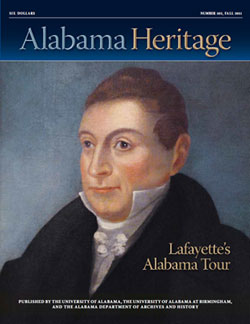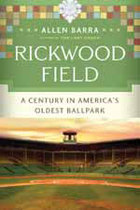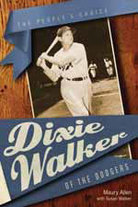|
On the cover: Portrait of the Marquis de Lafayette at the time of his Alabama tour. (Alabama Department of Archives and History)
|
FEATURE ABSTRACTS
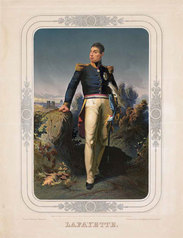 The Marquis de Lafayette
The Marquis de Lafayette(Library of Congress)
"The Nation's Guest": The Marquis De Lafayette's Tour of Alabama
By Edwin C. Bridges
As a Revolutionary War hero and beloved friend of George Washington, the Marquis de Lafayette occupied a significant place in nineteenth-century America. When he decided to visit Alabama as part of a tour of the United States, Lafayette set into motion one of the largest-scale celebrations the nascent state had ever staged. In a very special appearance, author Ed Bridges, Director of the Alabama Department of Archives and History, draws on historic items in the ADAH collection to illuminate the lavish reception accorded to Lafayette—and the tremendous bill that came with it.
About the Author
Edwin C. Bridges grew up in Bainbridge, Georgia, and graduated from Furman University. His MA and PhD degrees are from the University of Chicago. He taught high school in Greenville, South Carolina, and as an adjunct at Georgia Tech before joining the Georgia Department of Archives and History. He was appointed director of the Alabama Department of Archives and History in 1982, where he has served for the last twenty-nine years (and has repeatedly expressed his gratitude for the privilege of working in that wonderful institution). He has been involved in a wide variety of historical activities across Alabama, including serving on the editorial board of Alabama Heritage since its inception.
By Edwin C. Bridges
As a Revolutionary War hero and beloved friend of George Washington, the Marquis de Lafayette occupied a significant place in nineteenth-century America. When he decided to visit Alabama as part of a tour of the United States, Lafayette set into motion one of the largest-scale celebrations the nascent state had ever staged. In a very special appearance, author Ed Bridges, Director of the Alabama Department of Archives and History, draws on historic items in the ADAH collection to illuminate the lavish reception accorded to Lafayette—and the tremendous bill that came with it.
About the Author
Edwin C. Bridges grew up in Bainbridge, Georgia, and graduated from Furman University. His MA and PhD degrees are from the University of Chicago. He taught high school in Greenville, South Carolina, and as an adjunct at Georgia Tech before joining the Georgia Department of Archives and History. He was appointed director of the Alabama Department of Archives and History in 1982, where he has served for the last twenty-nine years (and has repeatedly expressed his gratitude for the privilege of working in that wonderful institution). He has been involved in a wide variety of historical activities across Alabama, including serving on the editorial board of Alabama Heritage since its inception.
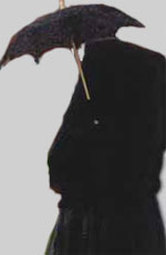 Huggin' Molly
Huggin' Molly (Robin McDonald)
Phantoms of the Wiregrass: Tracing the Incarnations of Alabama Folklore
By Nancy Gregory McLendon
Before humans recorded narratives in writing, they told stories as a way to preserve their cultural heritage and crucial information. Although the art of storytelling is less prominent today than previously, stories continue to circulate throughout communities, preserving legends, offering implicit moral advice, and sometimes even instilling fear in listeners. Nancy Gregory McLendon traces the role of folklore through the tale of Huggin' Molly, an example of the southern ghost story at its finest.
Additional Information
For further reading on this article's topics, the author recommends the following:
About the Author
Nancy Gregory McLendon teaches English and reading at Wallace Community College in Dothan, Alabama. While growing up in Abbeville, Alabama, she spent Sunday afternoons with grandparents and cousins listening to ghost stories, including the town's favorite, "Huggin' Molly." After receiving her BA from Samford University in 1967, she completed the MEd from the University of South Alabama and a PhD in Curriculum and Teaching of Reading from Auburn University in 2008. She especially enjoys retelling stories she heard from her childhood years. A true tale of intrigue, "Sylvia's Story," appears in the 2006 issue ofCrossroads, a Southern Culture Annual, Mercer University Press. The plot revolves around a mysterious poisoning in Abbeville and a young black woman who was almost hanged for a crime she did not commit. Currently, McLendon is writing a collection of Wiregrass ghost stories for young adult readers.
By Nancy Gregory McLendon
Before humans recorded narratives in writing, they told stories as a way to preserve their cultural heritage and crucial information. Although the art of storytelling is less prominent today than previously, stories continue to circulate throughout communities, preserving legends, offering implicit moral advice, and sometimes even instilling fear in listeners. Nancy Gregory McLendon traces the role of folklore through the tale of Huggin' Molly, an example of the southern ghost story at its finest.
Additional Information
For further reading on this article's topics, the author recommends the following:
- Solomon, Jack and Olivia. Ghosts and Goosebumps: Ghost Stories, Tall Tales, and Superstitions from Alabama. (The University of Georgia Press, 1994) (Click here to see where this book can be purchased.)
- Saxon, Dreyer, and Tallant. Gumbo Ya Ya, Folk Tales of Louisiana. (Pelican Publishing, 1987)
- Congdon, Kristin G. Uncle Monday and Other Florida Tales. (University Press of Mississippi, 2001)
- Huggin' Molly's Restaurant
- Margaret Walker Center
- Kathryn Tucker Windham's 13 Alabama Ghosts and Jeffrey
About the Author
Nancy Gregory McLendon teaches English and reading at Wallace Community College in Dothan, Alabama. While growing up in Abbeville, Alabama, she spent Sunday afternoons with grandparents and cousins listening to ghost stories, including the town's favorite, "Huggin' Molly." After receiving her BA from Samford University in 1967, she completed the MEd from the University of South Alabama and a PhD in Curriculum and Teaching of Reading from Auburn University in 2008. She especially enjoys retelling stories she heard from her childhood years. A true tale of intrigue, "Sylvia's Story," appears in the 2006 issue ofCrossroads, a Southern Culture Annual, Mercer University Press. The plot revolves around a mysterious poisoning in Abbeville and a young black woman who was almost hanged for a crime she did not commit. Currently, McLendon is writing a collection of Wiregrass ghost stories for young adult readers.
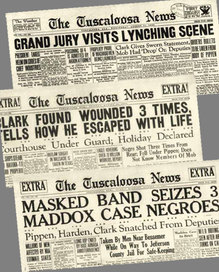 The rape and murder of Vaudine Maddox
The rape and murder of Vaudine Maddoxmade headlines for several months
(Tuscaloosa News)
"Martyrs...to a Mock Cause": Murder, Mayhem, and an Honorable Scrubbing in Tuscaloosa
By B. J. Hollars
After a young white woman was murdered in Tuscaloosa in 1933, several African American men were arrested for the crime. The case attracted national attention, while the accused men drew visits, along with offers of legal support and defense, from members of the International Labor Defense, a northern group with Communist ties. Tuscaloosa's citizens, skeptical of the perceived intrusion, took matters into their own hands—with deadly results and an image in need of scrubbing. Based on author B. J. Hollars's book Thirteen Loops: Race, Violence, and the Last Lynching in America, available from University of Alabama Press.
Additional Information
B. J. Hollars's book is available from University of Alabama Press.
About the Author
B. J. Hollars is an assistant professor of creative writing at the University of Wisconsin-Eau Claire and a former instructor at the University of Alabama. He is the author of the book Thirteen Loops: Race, Violence, and the Last Lynching in America (University of Alabama Press, 2011) and the editor of You Must Be This Tall To Ride: Contemporary Writers Take You Inside The Story (Writer's Digest Books, 2009) and Blurring the Boundaries: Explorations to the Fringes of Nonfiction (University of Nebraska, 2012).
By B. J. Hollars
After a young white woman was murdered in Tuscaloosa in 1933, several African American men were arrested for the crime. The case attracted national attention, while the accused men drew visits, along with offers of legal support and defense, from members of the International Labor Defense, a northern group with Communist ties. Tuscaloosa's citizens, skeptical of the perceived intrusion, took matters into their own hands—with deadly results and an image in need of scrubbing. Based on author B. J. Hollars's book Thirteen Loops: Race, Violence, and the Last Lynching in America, available from University of Alabama Press.
Additional Information
B. J. Hollars's book is available from University of Alabama Press.
About the Author
B. J. Hollars is an assistant professor of creative writing at the University of Wisconsin-Eau Claire and a former instructor at the University of Alabama. He is the author of the book Thirteen Loops: Race, Violence, and the Last Lynching in America (University of Alabama Press, 2011) and the editor of You Must Be This Tall To Ride: Contemporary Writers Take You Inside The Story (Writer's Digest Books, 2009) and Blurring the Boundaries: Explorations to the Fringes of Nonfiction (University of Nebraska, 2012).
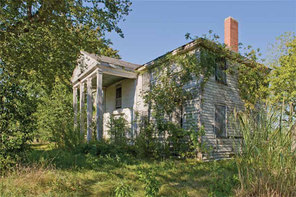 Bermuda Hill
Bermuda Hill(Robin McDonald)
Places in Peril 2011: Alabama's Endangered Historic Landmarks
By Donna Castellano and David Schneider
Each year, Places in Peril highlights significant historical properties in need of preservation or restoration. This year's list features a variety of structures throughout the state, from religious sites and historic homes to civic and commercial buildings. In addition, the annual list calls much-needed attention to the plight of historic movie theaters statewide. Each of these places would benefit from the interest and efforts of local preservationists.
In addition to the normal installment of Places in Peril, this year's list also considers the recent storm damage. The spring tornadoes that ravaged Alabama left a wake of destruction that is still being assessed. Bob Gamble takes a preliminary survey of historic structures damaged or destroyed by the storms.
About the Authors
Donna Castellano has spent the past twenty-five years researching, writing, and preserving Alabama history. She holds an MA in history from the University of Alabama in Huntsville and is the principal of EmbarkAlabama, a freelance writing and public relations firm. She is the author of Through the Garden Gate: The Gardens of Historic Huntsville and A Century of Service: Celebrating 100 Years of the YMCA in the Valley.
David B. Schneider is the executive director of the Alabama Trust for Historic Preservation. With thirty years of professional historic preservation experience, Schneider has been the principal of Schneider Historic Preservation, LLC, since 1999. He is the former executive director of the Historic Beaufort (SC) Foundation (1995–1999); the Historic Preservation Trust of Lancaster County (PA) (1990–1995); and the Berkeley County (SC) Historical Society Museum (1989–1990). He holds an MA in Historic Preservation from Middle Tennessee State University (1981) and a bachelor's in business administration from the University of Georgia (1979).
By Donna Castellano and David Schneider
Each year, Places in Peril highlights significant historical properties in need of preservation or restoration. This year's list features a variety of structures throughout the state, from religious sites and historic homes to civic and commercial buildings. In addition, the annual list calls much-needed attention to the plight of historic movie theaters statewide. Each of these places would benefit from the interest and efforts of local preservationists.
In addition to the normal installment of Places in Peril, this year's list also considers the recent storm damage. The spring tornadoes that ravaged Alabama left a wake of destruction that is still being assessed. Bob Gamble takes a preliminary survey of historic structures damaged or destroyed by the storms.
About the Authors
Donna Castellano has spent the past twenty-five years researching, writing, and preserving Alabama history. She holds an MA in history from the University of Alabama in Huntsville and is the principal of EmbarkAlabama, a freelance writing and public relations firm. She is the author of Through the Garden Gate: The Gardens of Historic Huntsville and A Century of Service: Celebrating 100 Years of the YMCA in the Valley.
David B. Schneider is the executive director of the Alabama Trust for Historic Preservation. With thirty years of professional historic preservation experience, Schneider has been the principal of Schneider Historic Preservation, LLC, since 1999. He is the former executive director of the Historic Beaufort (SC) Foundation (1995–1999); the Historic Preservation Trust of Lancaster County (PA) (1990–1995); and the Berkeley County (SC) Historical Society Museum (1989–1990). He holds an MA in Historic Preservation from Middle Tennessee State University (1981) and a bachelor's in business administration from the University of Georgia (1979).
To read about more places in peril, click here for our Places in Peril blog.
DEPARTMENT ABSTRACTS
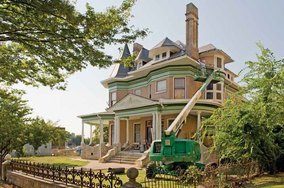 Ira and Shelia Chaffin provided
Ira and Shelia Chaffin providedarchitectural and woodworking expertise
to revive the historic structure.
(Robin McDonald)
Southern Architecture and Preservation
A Victorian Lady Gets a New Start
By James Baños
Most of Birmingham's private homes from the Victorian era fell to the ravages of disrepair or commercial development, but the house known as the "Twenty Twenty-Eight Building" survived intact into the twenty-first century. Preservationist James Baños details how the combined efforts of people across several eras helped protect this significant structure for future generations.
About the Author
Originally from Louisiana, James Baños is now a practicing clinical neuropsychologist in Birmingham who enjoys exploring regional history and architecture through research, photography, and pen and ink drawing. Robert Gamble, standing editor of the "Southern Architecture and Preservation" department of Alabama Heritage, is senior architectural historian for the Alabama Historical Commission.
A Victorian Lady Gets a New Start
By James Baños
Most of Birmingham's private homes from the Victorian era fell to the ravages of disrepair or commercial development, but the house known as the "Twenty Twenty-Eight Building" survived intact into the twenty-first century. Preservationist James Baños details how the combined efforts of people across several eras helped protect this significant structure for future generations.
About the Author
Originally from Louisiana, James Baños is now a practicing clinical neuropsychologist in Birmingham who enjoys exploring regional history and architecture through research, photography, and pen and ink drawing. Robert Gamble, standing editor of the "Southern Architecture and Preservation" department of Alabama Heritage, is senior architectural historian for the Alabama Historical Commission.
AH Update
To Kill a Mockingbird Letters
By Susan Reynolds
Everyone dreams of going to a yard sale and stumbling on a treasure, but few people actually accomplish this. Tracy Kyser, an Alabama teacher, did just that when he purchased several authentic letters discussing To Kill a Mockingbird. One of the letters came from Harper Lee herself, and it stands as a rare moment when the reclusive author commented on her work.
About the Author
Susan Reynolds is associate editor for Alabama Heritage.
To Kill a Mockingbird Letters
By Susan Reynolds
Everyone dreams of going to a yard sale and stumbling on a treasure, but few people actually accomplish this. Tracy Kyser, an Alabama teacher, did just that when he purchased several authentic letters discussing To Kill a Mockingbird. One of the letters came from Harper Lee herself, and it stands as a rare moment when the reclusive author commented on her work.
About the Author
Susan Reynolds is associate editor for Alabama Heritage.
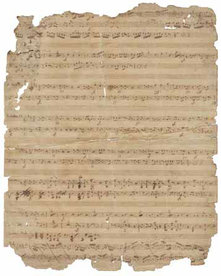 The original score of "Dixie"
The original score of "Dixie"(Alabama Department of Archives and History)
Becoming Alabama
Quarter by Quarter
By Joseph W. Pearson, Megan L. Bever, and Matthew L. Downs
Editor's Note: Alabama Heritage, the Summersell Center for Study of the South, the University of Alabama Department of History, and the Alabama Tourism Department offer this department as a part of the statewide "Becoming Alabama" initiative—a cooperative venture of state organizations to commemorate Alabama's experiences related to the Creek War, the Civil War, and the civil rights movement. Quarter by quarter we will take you to the corresponding seasons 200, 150, and 50 years ago—sometimes describing the most pivotal events, sometimes describing daily life, but always illuminating a world in flux. We will wait for the ultimate outcomes as our forbears did—over time. For those joining the story in progress, you can find earlier quarters on our website.
This quarter's installment of Becoming Alabama revisits the burgeoning tensions within the Creek Indian community, the first engagements of the Civil War, and the Massive Resistance aspect of the civil rights movement. In the fall of 1811, traditional Creek life faced many threats—from encroaching white settlers, certainly, but also from more modern-leaning factions of Creeks themselves. In 1861, victory in the Battle of Manassas bolstered the Confederacy's spirits and renewed its vigor for the war effort. And in 1961, opponents to the civil rights movement formed White Citizens' Councils to help resist further change.
About the Authors
Joseph W. Pearson is a PhD student in the department of history at the University of Alabama. His research interests include the nineteenth-century South, antebellum politics, and political culture.
Megan L. Bever is currently a doctoral student in the department of history at the University of Alabama. Her research interests include the nineteenth-century South and the Civil War in American culture.
Matthew L. Downs (PhD, Alabama) is an assistant professor of history at the University of Alabama at Birmingham. His dissertation focused on the federal government's role in the economic development of the Tennessee Valley.
Quarter by Quarter
By Joseph W. Pearson, Megan L. Bever, and Matthew L. Downs
Editor's Note: Alabama Heritage, the Summersell Center for Study of the South, the University of Alabama Department of History, and the Alabama Tourism Department offer this department as a part of the statewide "Becoming Alabama" initiative—a cooperative venture of state organizations to commemorate Alabama's experiences related to the Creek War, the Civil War, and the civil rights movement. Quarter by quarter we will take you to the corresponding seasons 200, 150, and 50 years ago—sometimes describing the most pivotal events, sometimes describing daily life, but always illuminating a world in flux. We will wait for the ultimate outcomes as our forbears did—over time. For those joining the story in progress, you can find earlier quarters on our website.
This quarter's installment of Becoming Alabama revisits the burgeoning tensions within the Creek Indian community, the first engagements of the Civil War, and the Massive Resistance aspect of the civil rights movement. In the fall of 1811, traditional Creek life faced many threats—from encroaching white settlers, certainly, but also from more modern-leaning factions of Creeks themselves. In 1861, victory in the Battle of Manassas bolstered the Confederacy's spirits and renewed its vigor for the war effort. And in 1961, opponents to the civil rights movement formed White Citizens' Councils to help resist further change.
About the Authors
Joseph W. Pearson is a PhD student in the department of history at the University of Alabama. His research interests include the nineteenth-century South, antebellum politics, and political culture.
Megan L. Bever is currently a doctoral student in the department of history at the University of Alabama. Her research interests include the nineteenth-century South and the Civil War in American culture.
Matthew L. Downs (PhD, Alabama) is an assistant professor of history at the University of Alabama at Birmingham. His dissertation focused on the federal government's role in the economic development of the Tennessee Valley.
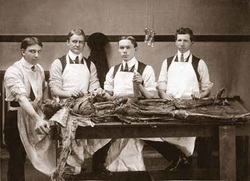 Students with a cadaver, c. 1905
Students with a cadaver, c. 1905(UAB Archives, University of Alabama at Birmingham)
Alabama Treasures
The Birmingham Medical College Scanning Project
By Tim L. Pennycuff
Although UAB is acclaimed for its medical school, not many people realize that Birmingham had another medical school at the turn of the century. Founded in 1894, the Birmingham Medical College was one of the state's two such programs. The school was short-lived, closing in 1915, but thanks to recent support from the National Library of Medicine, National Institutes of Health, records and archival materials from the Birmingham Medical College are now available in a searchable online database. Archivist Tim Pennycuff explores some of the collection's treasures.
About the Author
Tim L. Pennycuff is the university archivist at the University of Alabama at Birmingham.
Additional Information
After this article was published, a reader sent in a letter identifying a man in one of the article's pictures (right, and pg. 54 of the issue). The reader says that, in the photo of the four men next to a cadaver, the tallest man in the photograph (second from the left) is Dr. Samuel F. Nash.
The Birmingham Medical College Scanning Project
By Tim L. Pennycuff
Although UAB is acclaimed for its medical school, not many people realize that Birmingham had another medical school at the turn of the century. Founded in 1894, the Birmingham Medical College was one of the state's two such programs. The school was short-lived, closing in 1915, but thanks to recent support from the National Library of Medicine, National Institutes of Health, records and archival materials from the Birmingham Medical College are now available in a searchable online database. Archivist Tim Pennycuff explores some of the collection's treasures.
About the Author
Tim L. Pennycuff is the university archivist at the University of Alabama at Birmingham.
Additional Information
After this article was published, a reader sent in a letter identifying a man in one of the article's pictures (right, and pg. 54 of the issue). The reader says that, in the photo of the four men next to a cadaver, the tallest man in the photograph (second from the left) is Dr. Samuel F. Nash.
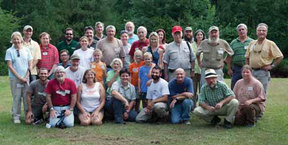 The Red Hills Salabrators, June 18, 2010
The Red Hills Salabrators, June 18, 2010(Beth Young)
Nature Journal
The Red Hills Salabration
By L. J. Davenport
This year marks the fiftieth anniversary of the discovery of Alabama's state amphibian, the Red Hills Salamander. Discovered by Leslie Hubricht, the elusive creature remains quite rare and is not sighted often. Larry Davenport recounts a commemorative visit to seek out and celebrate the species.
About the Author
Larry Davenport is a professor of biology at Samford University in Birmingham, Alabama. This column, running since 1993, inspired Davenport's award-winning book, Nature Journal (University of Alabama Press, 2010).
The Red Hills Salabration
By L. J. Davenport
This year marks the fiftieth anniversary of the discovery of Alabama's state amphibian, the Red Hills Salamander. Discovered by Leslie Hubricht, the elusive creature remains quite rare and is not sighted often. Larry Davenport recounts a commemorative visit to seek out and celebrate the species.
About the Author
Larry Davenport is a professor of biology at Samford University in Birmingham, Alabama. This column, running since 1993, inspired Davenport's award-winning book, Nature Journal (University of Alabama Press, 2010).
Reading the Southern Past
Alabama Baseball in Black and White
By Stephen Goldfarb
This quarter, Stephen Goldfarb takes up America's pastime and explores its Alabama connections. In a review of Allen Barra's Rickwood Field: A Century In America's Oldest Ballpark (W. W. Norton, 2010) and Maury Allen & Susan Walker's Dixie Walker of the Dodgers: The People's Choice (University of Alabama Press, 2010), Goldfarb traces both the sites and the people that enriched Alabama's ties to the sport and its fans.
About the Author
Stephen Goldfarb holds a PhD in the history of science and technology. He retired from a public library in 2003.
Alabama Baseball in Black and White
By Stephen Goldfarb
This quarter, Stephen Goldfarb takes up America's pastime and explores its Alabama connections. In a review of Allen Barra's Rickwood Field: A Century In America's Oldest Ballpark (W. W. Norton, 2010) and Maury Allen & Susan Walker's Dixie Walker of the Dodgers: The People's Choice (University of Alabama Press, 2010), Goldfarb traces both the sites and the people that enriched Alabama's ties to the sport and its fans.
About the Author
Stephen Goldfarb holds a PhD in the history of science and technology. He retired from a public library in 2003.
